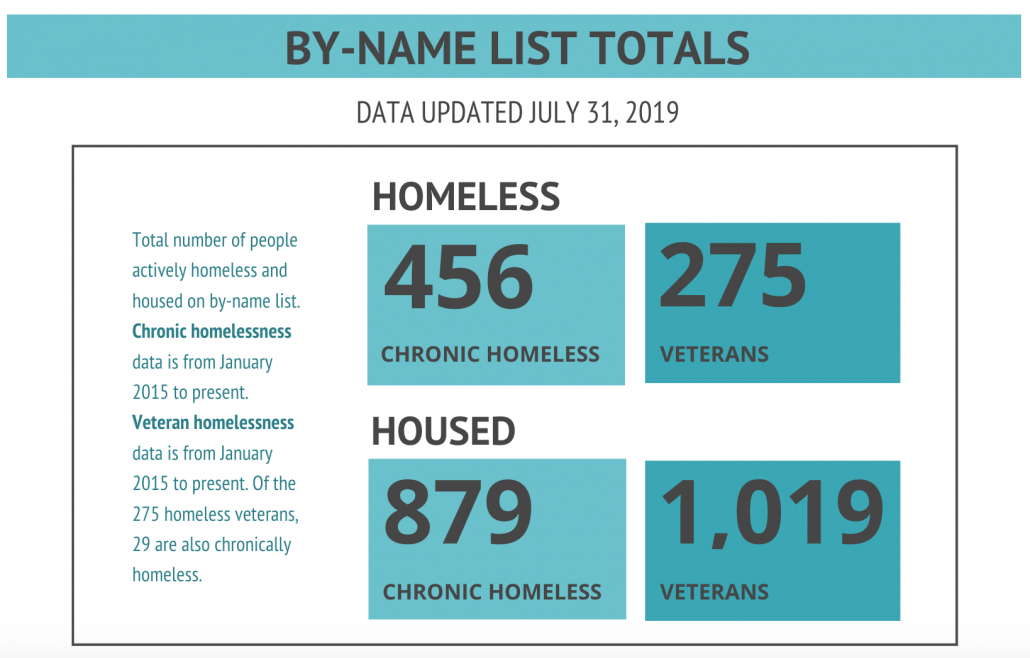Courtney Morton
Housing & Homelessness Research Coordinator
Mary Ann Priester
HMIS Administrator
Community Support Services partners with homeless service agencies in Charlotte-Mecklenburg to enter, collect, analyze and report data on housing and homelessness in the community. This June blog post describes the release of a new Housing Data Snapshot page, which provides regular reporting on three critical data points: the One Number, “By-Name” List Movement, and Coordinated Entry.
This blog provides the newest data update from the Housing Data Snapshot, highlights changes, and provides in-depth analysis to describe what these changes mean for Charlotte-Mecklenburg.
CHRONIC HOMELESSNESS
In July 2019, there are 456 chronically homeless individuals who are still homeless in Mecklenburg County. This number has continued to increase as inflow outpaces outflow. In July, the inflow was 26 compared with an outflow of 20, resulting in a net increase of 6 individuals homeless. Compared to the month prior, the number of chronically homeless individuals increased by 1%. During the past quarter, the average inflow is 29 individuals, whereas the average outflow is 23. Unless the outflow increases, (which requires new housing options) and/or inflow decreases (as a result of increased housing stability), the number of chronically homeless individuals will continue to increase.
VETERAN HOMELESSNESS
In July 2019, there are 275 veterans who are still homeless in Mecklenburg County. This number has continued to decrease as outflow outpaces inflow. In July, the inflow was 14 compared with an outflow of 35, resulting in a net decrease of 21 individuals homeless. Compared to the month prior, the number of homeless veterans decreased by 7%. During the past quarter, the average inflow is 15 individuals, whereas the average outflow is 27. To continue to decrease in veteran homelessness, housing resources must be targeted to reduce inflow and increase outflow.
COORDINATED ENTRY
Coordinated Entry data is updated with data quarterly. First quarter data (July – September) will be updated after October 1, 2019. Coordinated Entry data includes the number of 2-1-1 calls for housing assistance, the number of households referred for an in-person Coordinated Assessment, and the number of households who received an in-person Coordinated Assessment. In addition, a table is provided via this link to Coordinated Entry data for FY19.
The average number of monthly 2-1-1 calls for FY19 is 617 and the average number of monthly in-person Coordinated Assessments is 327. It is important to note that while these numbers help illustrate the need for housing in the community, they do not provide a full picture of all the households who face housing instability and homelessness and who do not seek assistance through the homeless services system.
SO, WHAT
In order to effectively address housing instability and homelessness, we must more completely understand the problem. Data provides us with a tool to do this. The data helps us understand the need of and demand for housing assistance.
When used effectively, these data points can inform decision-making around housing and homelessness. Working groups dedicated to reducing inflow and increasing outflow among chronic and veteran homelessness meet regularly to brainstorm and test methods that can create positive change. It is critical that these groups continue to examine the inflow and outflow patterns in relationship to changes in programs and policies.
More housing is needed. At the end of July, the total number of actively homeless veterans and chronically homeless individuals was 751. In addition, the average inflow numbers into homelessness for both further illustrate a continued need for housing. The numbers are also an important tool to estimate annual housing need for planners and funders.
Courtney Morton coordinates posts on the Building Bridges Blog. Courtney is the Housing & Homelessness Research Coordinator for Mecklenburg County Community Support Services. Courtney’s job is to connect data on housing instability, homelessness and affordable housing with stakeholders in the community so that they can use it to drive policy-making, funding allocation and programmatic change.


